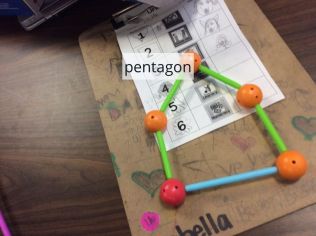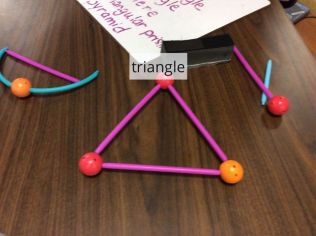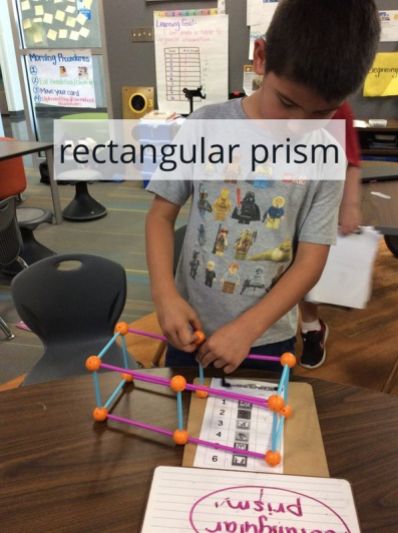Personally, I think  that geometry is one of the more concrete concepts for students to grasp in primary grades; quite literally. There are tons of ideas of how to construct shapes on the internet, in math books, etc. I love the activities with spaghetti and with Popsicle sticks and gumdrops, but those activities can be limiting when working with shapes with curved sides. These activities can be misleading when students decide to extend shapes and we have to be very careful that we not provide fixed and limiting language such as, “the gumdrops are the vertices” because that is not true in a shape like the one to the left.
that geometry is one of the more concrete concepts for students to grasp in primary grades; quite literally. There are tons of ideas of how to construct shapes on the internet, in math books, etc. I love the activities with spaghetti and with Popsicle sticks and gumdrops, but those activities can be limiting when working with shapes with curved sides. These activities can be misleading when students decide to extend shapes and we have to be very careful that we not provide fixed and limiting language such as, “the gumdrops are the vertices” because that is not true in a shape like the one to the left.
We recently bought a set from Learning Resources that, in my opinion, is the best out there for allowing students to construct two and three dimensional shapes and combine shapes to make new ones. I used these in my small groups to let students explore and then name their shapes. We use Seesaw in our classroom as a learning portfolio and after students made their shapes, they took a picture and labeled them on their Seesaw accounts.
The standard I had in mind with this exploration was: 1.GA.2: Compose two-dimensional shape or three-dimensional shapes to create a composite shape, and compose new shapes from the composite shape.
It’s so interesting to watch and listen as students construct their shapes. Just as with any creative activity, students who are identified as struggling learners by standardized tasks excel at the task and take the initiative and go further with their learning because they aren’t inhibited by language or symbols that they aren’t yet able to make sense of. Often the accelerated learners on standardized tasks do the bare minimum to complete the task and move on. I think these observable behaviors tell us a lot about the mindset of the student and their past experiences with learning. They also tell us which students value play and which value praise.
Misconceptions:

 Open-ended tasks like these are my favorite because they allow opportunities for students to explore misconceptions like the one here. This student doesn’t yet understand that a shape must be closed. This was an opportunity for me to quickly see that and perhaps more importantly for other students to notice and provide feedback. The picture on the right is the square after he corrected it (and his understanding of shapes).
Open-ended tasks like these are my favorite because they allow opportunities for students to explore misconceptions like the one here. This student doesn’t yet understand that a shape must be closed. This was an opportunity for me to quickly see that and perhaps more importantly for other students to notice and provide feedback. The picture on the right is the square after he corrected it (and his understanding of shapes).
This student had a misconception about circles and ovals which I may not have found so easily without this time to explore and create.
Differentiation:
These tasks are low entry, high ceiling opportunities because all students can make a shape and most students end up stretching their knowledge and vocabulary because they end up making shapes that they cannot name. This leads to all kinds of discussions on how to categorize shapes and the difference between two dimensional and three dimensional shapes. I provide students the written names of shapes once they name them and ask how to spell it or if they cannot name it and I am helping them name it for the first time. Here are some examples of two-dimensional shapes students created:
vocabulary because they end up making shapes that they cannot name. This leads to all kinds of discussions on how to categorize shapes and the difference between two dimensional and three dimensional shapes. I provide students the written names of shapes once they name them and ask how to spell it or if they cannot name it and I am helping them name it for the first time. Here are some examples of two-dimensional shapes students created:
Three-dimensional shapes:
Combining Shapes
 This student started out with a square and built onto it to make it a rectangle. She discovered how to
This student started out with a square and built onto it to make it a rectangle. She discovered how to  combine shapes to make new ones.
combine shapes to make new ones.
This student combed a 3D and a 2D shape to make a sculpture.
 This student is one of my very low performing student sin most subjects, but in math he excels because he is able to make sense of his own learning through play and discovery.
This student is one of my very low performing student sin most subjects, but in math he excels because he is able to make sense of his own learning through play and discovery. 
I used this picture earlier, but this student started with a cube and decided he wanted to extend it to see what it turned out to be. He needed help naming it, but loved that he had discovered a “new” shape.
Conclusion
We shouldn’t limit ourselves to tasks that offer fixed outcomes. We must search for tasks that allow students to be creative and “build” their own meaning. As you know, I am a huge proponent of STEAM integration in primary grades and this is just one example of a task that melds mathematics and 21st century skills. We need to let kids explore more and allow ourselves as educators to do less talking and more listening!













